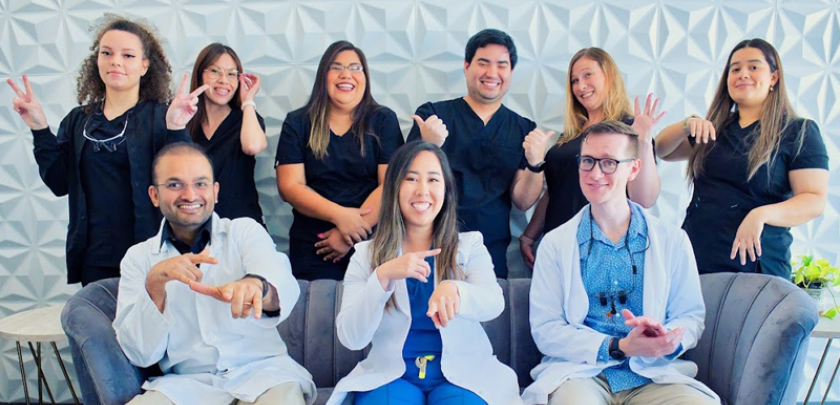$99 New Patient Special - Includes Exam, X-Ray and Basic Cleaning
How Long Does It Take For A Loose Tooth To Tighten Back Up?

Few things can be as concerning as discovering a loose tooth, whether in yourself or a loved one. The mind races with questions: What caused it? Can it be saved? How long until it tightens back up? In this blog, we’ll delve into the world of loose teeth, exploring the reasons behind their mobility and the intricate process of them regaining stability.
The Causes of Loose Teeth
Understanding why a tooth becomes loose is crucial in determining the appropriate steps for treatment and recovery. Here are some common causes:
1. Trauma: Accidents or injuries, such as a fall or a blow to the face, can result in a loose tooth. The force applied to the tooth can disrupt the supporting structures, leading to mobility.
2. Gum Disease: Periodontal diseases, such as gingivitis and periodontitis, are major contributors to tooth loss. These conditions compromise the integrity of the gums and bone supporting the teeth.
3. Bruxism (Teeth Grinding): Consistent grinding or clenching of teeth, known as bruxism, can gradually loosen teeth over time.
4. Tooth Abscess: Infections within the tooth or at the root can cause inflammation and damage to surrounding tissues, leading to tooth mobility.
5. Poor Oral Hygiene: Neglecting oral care can result in plaque buildup, which, if left untreated, can lead to gum disease and eventual tooth loosening.
The Process of Tooth Tightening
The body has a remarkable ability to heal, and this extends to the oral cavity. The process of a loose tooth tightening up involves a series of stages:
Inflammation Response: Upon injury or infection, the body initiates an inflammatory response. In the case of a loose tooth, this serves as the first line of defense against further damage.
Fibroblasts Activation: Fibroblasts, specialized cells responsible for producing connective tissue, are activated. These cells play a crucial role in rebuilding the damaged ligaments and tissues supporting the tooth.
Bone Remodeling: For teeth to regain stability, the bone surrounding them must undergo a remodeling process. Osteoblasts and osteoclasts, cells responsible for bone formation and resorption, work together to restore bone structure.
Reattachment of Ligaments: As the healing progresses, the ligaments that anchor the tooth to the bone gradually reattach. This reattachment is a critical step in achieving stability.
Gradual Tightening: With the support structures restored, the tooth undergoes a gradual tightening process. This may take several weeks to months, depending on the severity of the initial damage.
Factors Influencing the Healing Time
The time it takes for a loose tooth to tighten back up can vary based on several factors:
1. Severity of Injury or Disease: The extent of trauma or the progression of gum disease influences the complexity of the healing process. More severe cases may require a longer recovery time.
2. Age: Children and adolescents generally experience faster healing than adults. The regenerative capacity of tissues tends to be more robust in younger individuals.
3. Overall Health: The general health of an individual plays a crucial role in the healing process. A well-nourished body with a strong immune system is better equipped to facilitate a speedy recovery.
4. Oral Hygiene Practices: Maintaining good oral hygiene during the recovery period is essential. Proper care, including regular brushing, flossing, and dental check-ups, supports the healing process.
Tips for a Healthy Smile During Recovery
While the body works its magic to tighten a loose tooth, there are steps you can take to support the healing process and maintain overall oral health:
1. Gentle Oral Care: Be gentle when brushing and flossing to avoid putting additional stress on the affected tooth. A crucial aspect of facilitating the recovery of a loose tooth is adopting a gentle approach to oral care.
2. Antibacterial Mouthwash: Rinsing with an antibacterial mouthwash can help prevent infections and support a clean oral environment during the recovery period. Antibacterial mouthwash, a staple in many oral care routines, plays a crucial role in promoting a clean and healthy environment within the mouth.
3. Avoid Hard and Sticky Foods: Steer clear of foods that may exacerbate the situation. Hard or sticky foods can put unnecessary strain on the healing tooth. When dealing with a loose tooth, the choices you make in your diet can significantly impact the healing process.
4. Follow Dentist’s Advice: Listen to your dentist’s recommendations and follow their advice regarding medications, follow-up appointments, and any additional treatment needed.
5. Regular Dental Check-ups: Schedule regular check-ups with your dentist to monitor the progress of the healing and address any concerns promptly.
When to Seek Professional Help
While a loose tooth can tighten on its own in many cases, there are situations where professional intervention is necessary:
1. Persistent Mobility: If the tooth remains loose or continues to worsen despite home care, it’s crucial to seek dental attention.
2. Severe Pain: Intense pain around the loose tooth could indicate an underlying issue, such as an infection, and requires immediate dental assessment.
3. Changes in Color or Shape: A dentist should promptly address any changes in the color or shape of the loose tooth, as these could be signs of complications.
4. Swelling or Pus: Swelling, redness, or the presence of pus around the affected tooth are signs of infection and necessitate urgent dental care.
The journey of a loose tooth tightening back up is a fascinating testament to the body’s remarkable ability to heal. While the process may take time and patience, understanding the underlying causes and supporting the body’s natural healing mechanisms can contribute to a successful recovery. With the right care and attention, your smile can be on its way to regaining its strength and stability.
Looking For A Dentist In Georgetown, TX
If you ever have concerns about your dental health or need professional advice specific to your situation, don’t hesitate to reach out to a qualified Georgetown dentist. Your smile deserves







